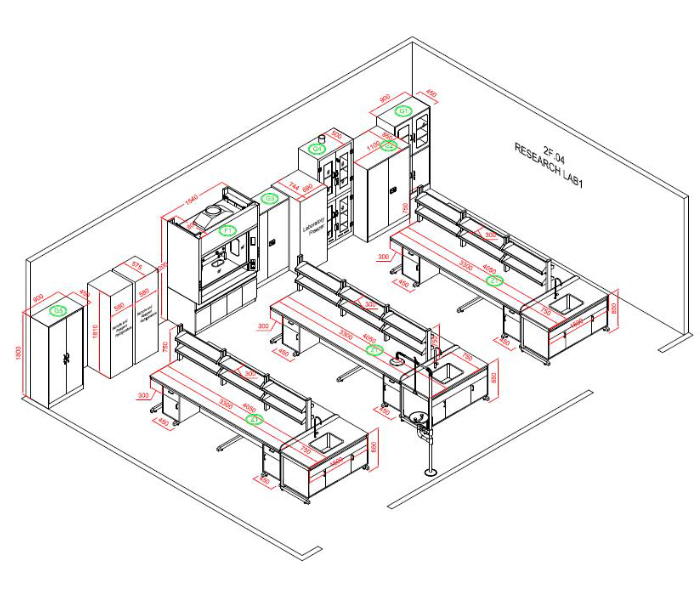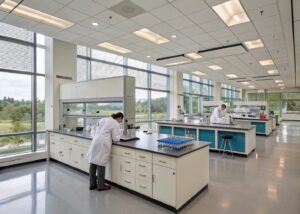Table of Contents
In today’s fast-paced scientific world, a well-designed laboratory is crucial for groundbreaking discoveries and efficient research. Whether you’re building a new lab from scratch or renovating an existing space, optimizing your lab layout design can significantly impact your team’s productivity and overall laboratory efficiency. This comprehensive guide will walk you through proven strategies for creating a high-performance laboratory that maximizes space utilization and streamlines workflow optimization.
Understanding the Importance of Effective Lab Layout Design
Before diving into specific design strategies, it’s essential to recognize why lab layout design matters. A thoughtfully planned laboratory can:
Enhance safety protocols
Improve research productivity
Reduce equipment downtime
Minimize contamination risks
Boost team collaboration and communication
Key Principles for Maximizing Space and Efficiency
Prioritize Workflow Analysis
The foundation of any successful lab layout design is a thorough understanding of your team’s workflows. Conduct a comprehensive analysis of current processes, identifying bottlenecks and inefficiencies. This information will guide your design decisions and help create a layout that supports seamless workflow optimization.
Implement Flexible and Modular Design
Modern laboratories need to adapt quickly to changing research needs. Incorporate modular furniture and equipment that can be easily reconfigured. This flexibility allows for:
- Rapid adaptation to new projects
- Efficient use of limited space
- Easy integration of new technologies
Optimize Equipment Placement
Strategic placement of laboratory equipment is crucial for laboratory efficiency. Consider the following:
- Group frequently used equipment together
- Place shared equipment in easily accessible central locations
- Ensure adequate space around equipment for maintenance and operation
Create Dedicated Zones
Divide your laboratory into distinct zones based on function:
- Wet lab areas
- Dry lab spaces
- Write-up and data analysis stations
- Storage zones
- Collaborative spaces
This zoning approach enhances workflow optimization by minimizing cross-contamination risks and reducing unnecessary movement.
Prioritize Safety and Compliance
Incorporate safety features into your lab layout design from the outset:
- Ensure clear paths to emergency exits and safety equipment
- Install proper ventilation systems
- Designate areas for personal protective equipment (PPE)
- Design with ADA compliance in mind
Leverage Vertical Space
In many laboratories, floor space is at a premium. Maximize your available area by thinking vertically:
- Install overhead storage systems
- Use wall-mounted shelving and equipment racks
- Consider mezzanine levels for office or storage spaces
Incorporate Collaborative Spaces
Foster innovation and team communication by designing areas for collaboration:
- Create open meeting spaces within the lab
- Design shared write-up areas
- Implement digital collaboration tools and displays
Plan for Future Growth
A forward-thinking lab layout design should accommodate future expansion:
- Leave room for additional equipment
- Design flexible spaces that can be repurposed
- Consider modular walls and partitions for easy reconfiguration
Leveraging Technology for Enhanced Laboratory Efficiency
Integrate smart technologies to further boost your laboratory efficiency:
- Laboratory Information Management Systems (LIMS)
- Internet of Things (IoT) enabled equipment for real-time monitoring
- Automated inventory management systems
- Virtual reality tools for collaborative research and training
Conclusion: The Path to a High-Performance Laboratory
Designing a high-performance laboratory is a complex but rewarding process. By focusing on workflow optimization, flexibility, and efficient space utilization, you can create a laboratory environment that not only meets your current needs but also adapts to future challenges. Remember, the key to successful lab layout design lies in understanding your unique requirements and applying these principles thoughtfully.
Are you ready to transform your laboratory into a model of efficiency and innovation? Start by assessing your current layout and identifying areas for improvement. With careful planning and implementation of these strategies, you’ll be well on your way to designing a laboratory that sets new standards for performance and productivity.




